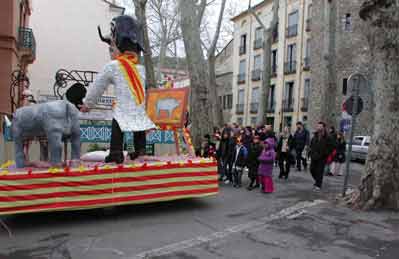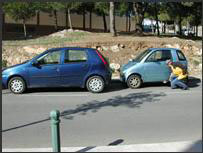Art Tourist at the Dali Museum in Figueras
It's an interesting mess
by Terry Talty
FIGUERAS – In this Spanish town close to the French border where Salvador Dali was born, the local officials of the 60s and 70s created for their town a gold mine – the Dali Museum. Cluttered and overdone, the creators of the place have housed a tempest in ancient theatre. As my companion said, ≥It gives a person a real insight into why this artist made the kind of work he made.≤ My companion does not like messy work, and the main reason this museum is messy is the work itself. Dali was involved in the creation of the museum while he was living in a nearby town.
Cluttered and overdone, the creators of the place have housed a tempest in ancient theatre. As my companion said, ≥It gives a person a real insight into why this artist made the kind of work he made.≤ My companion does not like messy work, and the main reason this museum is messy is the work itself. Dali was involved in the creation of the museum while he was living in a nearby town.
This began in the late 60s, opened in 1970 long after he had grown up, left Spain, become famous and returned to take a summerhouse near his birthplace. This museum was created in the ruins of the theatre, built in a period when the theaters were small in diameter, but tall. The audience was close to the stage, close enough to hear even when far up in the ≥peanut≤ gallery.
 After you enter the museum prepare to be subjected to room after room of Dali's baroque, searching-for-the-thing-to-break-the-barrier-of-acceptable art, punctuated calmly by some bigger spaces. At the center of what was once the theatre, we saw some crazy giant – 5 meters maybe -- assemblage of an old Cadillac, a towering old statue and gigantic drips of paint. But back where the stage and spectacle would have been created, an enormous Dali painting hangs behind a theatrical – draped open – curtain, from a wood slate that is mirrored by another slat at the bottom that stretches the painting tight in the vertical direction and relatively tight in the horizontal, but because it is fluid this way, it seems less pompous that a painting and somewhat like drapery. I go to the bother of explaining this because, it made me laugh – many of the things in this museum would -- and I respected Dali for being able to laugh at himself. It's one of the several great big well-crafted paintings Dali made. For these, I expected before I entered I would enjoy the museum.
After you enter the museum prepare to be subjected to room after room of Dali's baroque, searching-for-the-thing-to-break-the-barrier-of-acceptable art, punctuated calmly by some bigger spaces. At the center of what was once the theatre, we saw some crazy giant – 5 meters maybe -- assemblage of an old Cadillac, a towering old statue and gigantic drips of paint. But back where the stage and spectacle would have been created, an enormous Dali painting hangs behind a theatrical – draped open – curtain, from a wood slate that is mirrored by another slat at the bottom that stretches the painting tight in the vertical direction and relatively tight in the horizontal, but because it is fluid this way, it seems less pompous that a painting and somewhat like drapery. I go to the bother of explaining this because, it made me laugh – many of the things in this museum would -- and I respected Dali for being able to laugh at himself. It's one of the several great big well-crafted paintings Dali made. For these, I expected before I entered I would enjoy the museum.
Other art tourists have said to me that the museum isn't worth the bother, but that the building is worth seeing. As we stood outside it, directed by signs to a ticket both where the teller said go around, where we tried to sneak a peak at the museum by walking in a well dark and mysterious curved steel revolving door, and wondered whether it would be worth the money to enter. We resigned ourselves to paying 5 euro or so, as the ticket window (obviously for something other than the museum) said, and went around the building to a courtyard, with three giant copies of each other – old statues on top of a pile of truck tires. There were intriguing for their scale and totem pole quality, they each had a different title although they were some famous man of letters reproduced in concrete three times. The title plate was also made of concrete (or stone) and was placed to that the first tire would pinch it. Vandal proof and a cool part of the sculpture, as the big rubber thing had to mold around it.
So here's the gold mine part the town created. It was 10 euros each to enter – no credit cards, thank you – and they don't need a giant curatorial staff or budget to bring in revolving shows to attract new visitors. They have so much stuff to show.
Room after hallway after room of Dali black and white drawings, piles of cast plaster sculpture, reproducible jewelry, and drawings and paintings with various techniques he tried, his friends' work, his crazy furniture and stuff he seems to have collected. As my companion said, ≥I don't think he threw very much away.≤
From the eggs rising from the roof, and the loaves of bread stuck on the wall like ornaments to the interior of the old theatre where each niche is filled with a gold painted former mannequin, the place is a bombardment of stimulus before you add the art work. And the artwork continues the assault.
So here is the real genius of curation. I actually enjoyed seeing several paintings, several galleries were calm and pleasant to visit, and by the time the experience was over I respected Dali for his relentlessness in another area. He was trying to push the idea of art as far as he could as well as the amount of imagery he threw at the world. He used holograms, used the ideas that were latter made into those magic eye books and exploded his own paintings into sculpture. He was an installation and performance artist before anyone was called that.